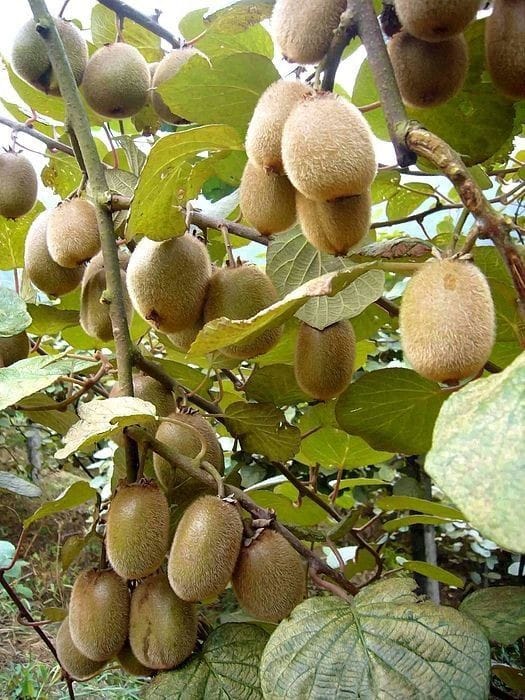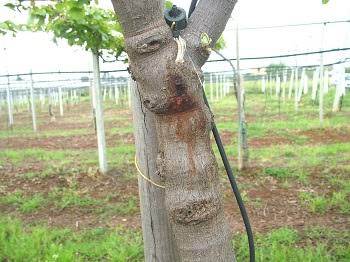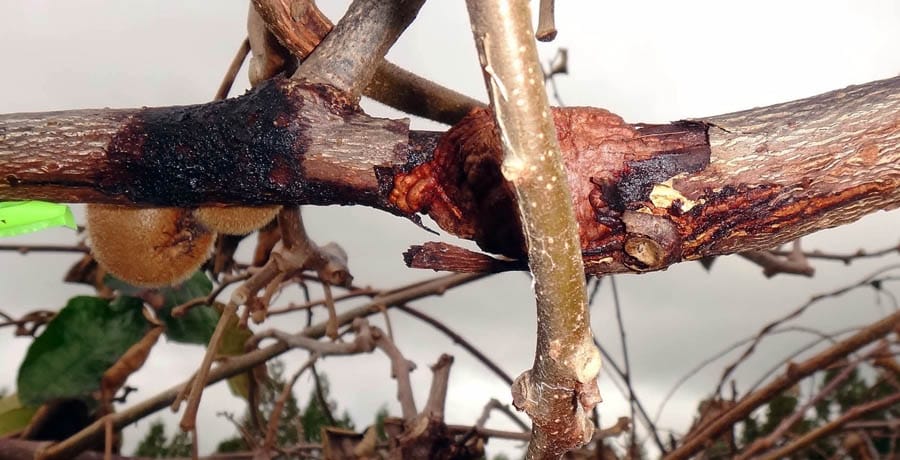Arctic Kiwi
Arctic kiwi vines, 10-20 feet tall in Zones 3-8, grow rapidly in well-drained soil under full sun to partial shade. Known for their small and edible kiwis, Arctic kiwis are hardy in colder climates.

Habit
Vine
Height
3-6 m (vine)
Growth
Fast
Soil
Well-drained loamy soil
Shade
Full sun to partial shade
Moisture
Moderate
Edible
Yes
Medicinal
Yes
Origin
East Asia
Climatic Condition
Temperate
Temperature (°)
10-20°C
Humidity (%)
60-80%
Potting media
Garden soil
Fertilizers
Balanced NPK
Watering
Regular watering, especially during dry periods
Plant Weight
2-5 kg
Flowering Time
Spring
Soil Ph level
5.0 - 6.5
Water Ph level
6.0 - 7.0
Soil EC
Medium
Yield Per Plant
50-100 kg of fruits per year
NPK ratio
10:10:10
life Span
50+ years
Health Benefits
High in vitamin C; supports immune health.
Suggested Grow Media or Potting Mix ?
50% loam, 30% compost, 20% sand
Suggested Fertigation/Fertilizers
Fertilize every 4 weeks during growing season with balanced fertilizer.
Common Diseases and Remedies
Bleeding Canker, Botrytis Fruit Rot
Externally, cane symptoms include dried, shriveled bark, Symptoms of decay and signs of the pathogen develop as shriveled fruit
Prune infected vines
HEALTH BENEFITS
1. Rich in Vitamin C: Boosts the immune system, Supports collagen production for healthy skin, Acts as an antioxidant to reduce inflammation
2. High in Fiber: Aids digestion and promotes gut health, Helps regulate blood sugar levels, Supports heart health by lowering cholesterol
3. Packed with Antioxidants: Contains polyphenols and flavonoid’s that fight oxidative stress, May reduce the risk of chronic diseases like cancer and heart disease
4. Good for Eye Health: Contains lutein and zeaxanthin, which support vision and may prevent macular degeneration
5. Supports Heart Health: Rich in potassium, which helps regulate blood pressure, Contains healthy plant compounds that improve blood circulation
6. May Enhance Metabolism and Energy: Provides natural sugars and essential nutrients for sustained energy, A good snack for athletes and active individuals
What Is An Arctic Kiwi Tree ?
Arctic kiwi, also known as hardy kiwi or kiwi, is a small fruit that is a close relative of the kiwi. It is native to Southeast Asia and is known for its cold hardiness, making it suitable for growing in cold climates. Arctic kiwifruit plants are generally more compact than kiwifruit, making them easier to manage in small gardens.

What Are The Different Types Of Arctic Kiwi Plants?
1. Soft Date Kiwi 'Ananasnaya'
Known for its pineapple-like taste, this variety is one of the most popular of the Arctic kiwi plants.
2. Soft Date Kiwi 'Issai'
This variety is self-fertile, meaning there is no need to separate male and female plants to produce fruit. It is also known for its desserts.
3. Actinidia jujube 'Ken Hong'
This species is famous for its red fruits and is often used as an ornamental tree in addition to growing its fruits.
4. Soft Date Kiwi 'Weiki'
This variety is known for its large fruit and is often used in commercial production.
5. Actinidia kolomikta
This variety is known for its variegated leaves that can be pink, white or green. It produces small, yellow-green fruits.

How to Care for Arctic Kiwi ?
1. Location
species of Arctic kiwifruit (Actinidia kolomikta) are found in eastern Siberia, Japan, Korea and northern China. They are hardy in USDA zones 3-8, which means they can withstand temperatures as low as -40°F (-40°C). They prefer full sun to partial shade and well-drained, slightly acidic soil. They can be planted in containers or in the ground but will need a trellis or other support to climb. They are dioecious, meaning you need both male and female plants to produce fruit. Male plants have colourful leaves, while female plants bear fruit.
2. Sunshine
Arctic kiwi plant (Actinidia kolomikta) prefers full sun to partial shade. They can tolerate some shade, especially in hot weather, but will produce more fruit in full sun. If you live in a hot climate, providing some afternoon shade can help protect your plants from intense heat. In cold climates, full sun is best to help plants grow and bear fruit.
3. Soil
Arctic kiwi plant (Actinidia kolomikta) prefers well-drained, slightly acidic soil. A pH range of 5.5 to 7.0 is ideal. They do not like heavy clay and constantly wet soil. Adding organic matter such as compost or well-rotted manure will help improve soil drainage and fertility. It's also a good idea to add mulch around the base of your plants to help retain moisture and reduce weeds.
4. Hydration
Arctic kiwi plant (Actinidia kolomikta) should be watered regularly, especially during the growing season. They like moist but not saturated soil. Water deeply and cleanly, allowing the soil to dry slightly between watering. They will need water more frequently in hot weather. It is also important to water the lower part of the plant, not the upper part, against fungal diseases. Adding a layer of mulch around the base of the plant can help retain moisture and reduce the need for watering.

5. Nourishment
Arctic kiwifruit plants (Actinidia kolomikta) benefit from regular cropping to promote good growth and fruit production. A balanced, slow-release fertilizer with a ratio of 10-10-10 or similar is suitable. Fertilize in early spring before new growth begins and again in late spring or early summer after the plants have bloomed. Avoid fertilizing in late summer or fall because this encourages new growth that will be damaged by frost. It's also a good idea to add a layer of compost or well-rotted manure around the base of your plant each spring to help improve soil fertility and structure.
6. Issues
Arctic kiwi( Actinidia kolomikta) are generally easy to grow but can be subject to some Issues : Arctic kiwifruit plants are hardy in USDA zones 3-8, but they can be damaged by late spring frosts. To protect them, you can cover them with a tarp or blanket during the summer months. Arctic kiwi plants are dioecious, meaning both male and female plants are needed to produce fruit. If you have only one tree, you cannot bear fruit. Remember that for every 8-10 female plants there is at least one male plant. Arctic kiwi plants can become very large if left unpruned. Pruning can help maintain their size and shape and encourage fruit production. Prune in late winter or early spring before new growth begins. In cold climates, Arctic kiwifruit plants are damaged by winter weather. To protect them, you can cover them with a layer of mulch or straw in late fall.
What are the Benefits of Arctic Kiwi Plant ?
Arctic kiwi, also known as hard kiwi or kiwifruit (Actinidia arguta), is a small fruit similar in taste and appearance to the more familiar kiwi (Actinidia deliciosa). Some benefits of Arctic kiwi include: Arctic kiwi fruit is a good source of vitamin C, vitamin K, vitamin E and dietary fiber. It also contains antioxidants that help prevent oxidative stress and inflammation. Arctic kiwi is rich in vitamin C, which is important for the immune system. It also contains other nutrients such as vitamin K and vitamin E, which help support the immune system. Some studies show that Arctic kiwi may help improve blood sugar control in people with diabetes. Arctic kiwi fruit is low in calories and high in fiber. This may help with weight loss by filling the heart and reducing calorie intake. The antioxidants in arctic kiwi may help support healthy skin by helping protect against damage from UV rays and environmental pollution. Arctic kiwi fruit is rich in vitamin C, which is important for eye health. It also contains other nutrients such as vitamin E and lutein, which help prevent age-related macular degeneration and other eye diseases. Arctic kiwi is a good source of vitamin K, which is important for bone health. It also contains other nutrients such as calcium and magnesium, which help support strong, healthy bones. Overall, Arctic kiwi is a nutritious and delicious fruit that can make a healthy addition to your diet.

FAQs About Growing Arctic Kiwi
1. How to maintain arctic kiwi plants ?
Arctic kiwi plants prefer moist, but not waterlogged, soil. Water deeply and thoroughly, allowing the soil to dry out slightly between waterings. In hot weather, they may need more frequent watering. Arctic kiwi plants can become quite large if left unpruned. Pruning can help control their size and shape, as well as promote fruit production. Prune in late winter or early spring before new growth begins. Arctic kiwi plants are dioecious, which means you need both male and female plants to produce fruit. If you only have one plant, you won't get any fruit. Make sure you have at least one male plant for every 8-10 female plants. To protect them, you can cover them with a frost cloth or blanket when frost is expected. Common pests that can affect arctic kiwi plants include aphids, spider mites, and scale insects. These pests can be controlled with insecticidal soap or neem oil. Arctic kiwi plants can also be susceptible to fungal diseases such as powdery mildew and root rot. To prevent these diseases, avoid overhead watering, provide good air circulation, and avoid planting the plants too close together. In colder climates, arctic kiwi plants can be damaged by winter weather. To protect them, you can cover them with a layer of mulch or straw in late fall.
2. What are the uses of arctic kiwi plants ?
The most common use of arctic kiwi plants is for their edible fruit. The fruit is small, grape-sized, and similar in taste and appearance to the more familiar kiwifruit (Actinidia deliciosa). It can be eaten fresh, added to fruit salads, or used in jams, jellies, and desserts. Arctic kiwi plants are also grown for their ornamental value. They have attractive variegated foliage that can add colour and interest to the garden. The leaves are green with white or pink tips, and they turn pink or red in the fall. Arctic kiwi plants have a vigorous, spreading growth habit, which can help control erosion on slopes or hillsides. In traditional Chinese medicine, various parts of the arctic kiwi plant have been used to treat a variety of ailments, including digestive disorders, respiratory problems, and skin conditions
3. Can I grow arctic kiwi indoors ?
Yes, you can grow arctic kiwi (Actinidia arguta) indoors, but it's important to note that they are vigorous climbers and can grow quite large if not pruned regularly.
4. Which pot is best for growing arctic kiwi plants ?
When growing arctic kiwi plants (Actinidia arguta) in pots, it's important to choose a container that is large enough to accommodate their vigorous growth and has good drainage.
5. From where can I shop arctic kiwi plants ?
Arctic kiwi plants (Actinidia arguta) can be purchased from various sources, including local nurseries, garden centers, and online retailers.



